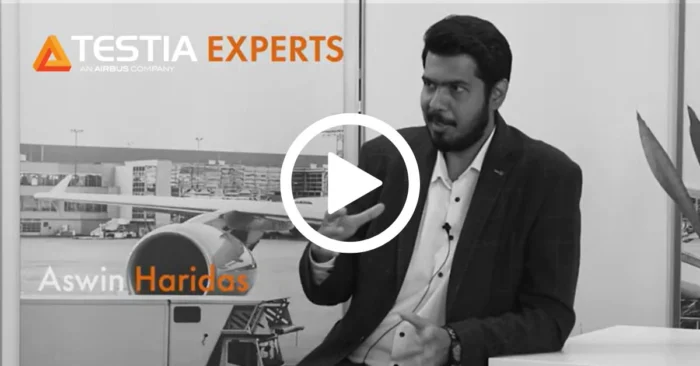In our article series “Testia Experts”, we present short interviews with our employees – the experts that really make Testia what it is. In this issue we speak with Aswin Haridas, who is our mastermind for structural health monitoring solutions.
You can also watch this interview on YouTube.
What is your career and education path?
As a team leader for Structural Health Monitoring (SHM), I work alongside a brilliant team of engineers. We strive to provide our customers with end-to-end structural health monitoring solutions. We make sure that we deliver high-quality solutions. We make sure that we deliver on time, and we make sure that our customers are happy.
So I was born and raised in India. In fact, I did my schooling and my bachelor’s in aerospace engineering there as well. Then I decided to move outside of India for my master’s, again in aerospace engineering, but with a focus on aerospace structures. And then I got the first taste of structural health monitoring, so to say.
After my master’s, I decided to start a small venture with a couple of friends, focusing on fiber-optic-based structural health monitoring solutions. I realized that there are more things to learn in this field, which led me to do my PhD in Singapore. I did it as an industrial PhD, along with Rolls-Royce aircraft engines and NTU, Nanyang Technological University in Singapore. The main focus was optical non-destructive testing and structural health monitoring solutions for aircraft engine components.
After my PhD, I realized that I wanted to have a more customer-facing kind of experience, which led me to choose Testia. And I’m here ever since.
What project are you currently working on?
I’m working on quite a few projects, but the one that comes to my mind concerns this technology called CVM, competitive vacuum monitoring. It’s a technology that is a high-technology ready solution developed for the aviation industry. The scope is to monitor the structure, to monitor cracks that are formed in the structure. This has been already implemented by airlines and MROs, and this is meant to be used as an alternate mean of inspection.
Here at Testia, we have worked together with the manufacturer of these sensors to develop a structured training program, which we offer to MROs and end-users. We have been part of this program since 2023-2024, and this has led us to think deeply in the field of structural health monitoring training. Now we are doing the first and only structural health monitoring training in the world. We are doing the first batch of training in Stanford, in California in September 2025. So I’m really excited to see how that develops.
As a focal point for SHM at Testia, which region is the most advanced in this area and why?
There’s no one answer to which region is best; each region has its own challenges. I think my role as a global focal point, the biggest added value that I see in my role, is that I get to understand the different pain points of customers globally. The more I hear, the more I learn. I see that there’s a lot of differences and a lot of similarities.
I’ve also learned that some technologies which can be applied in some regions could not be applied to others because of its geography, where it’s located, the kind of environment it is based in, and so on and so forth. So there is a need to understand the global picture, but there is not one region per se that’s doing the best.
What do you like the most about your job?
There are quite a few aspects, but what comes to the top of my head is the whole aspect of structural integrity and the whole philosophy of why structural integrity is important. I think a lot about structures and their value in our life, in our day-to-day life. Everybody knows about the house that you live in, the car that you drive, the aircraft that you fly. And it’s quite critical.
I see myself a bit as a doctor of structures, sort of trying to get this information from the structures about what their problems are. As humans, we can talk to our doctor and get prescription medicine, but the structures can’t do that. Structural health monitoring or non-destructive testing, for that matter, gives the structures a voice. So I feel that doing this makes me feel that we are helping the world be better, step by step.
This is also connected to climate change, by the way. I also feel that a lot of the aspects that we are dealing with right now with climate change and all of that is also affecting the structures in a good or a bad way. Getting more information from these structures also helps us understand how they can be used in the long run with the changing climate environments.
Finally, I think one of the biggest motivations that I have personally is with regards to this customer-facing role that I have. Having to meet with a lot of customers and discuss about their challenges and the issues that they face from all fronts—be it aerospace, automotive, wind turbines, or infrastructure—the whole horizontal information that’s made available to you from all the different sectors helps you really understand and deliver solutions which are really attacking a problem. And I feel that Testia offers me this opportunity to understand this on a broad sense and to be able to deliver appropriate solutions. So I feel very much obliged and happy to be here.
Watch the video interview on YouTube
Thanks for taking the time for this interview!
Are you interested in also becoming a Testia expert? Visit our career page to find out about our current job offers!


